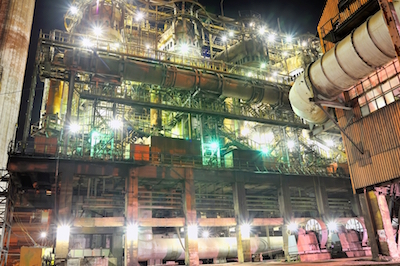Spending falls in April but rises year-to-date; Beige Book finds increasing demand, costs
 Editor’s note: Construction Citizen is proud to partner with AGC America to bring you AGC Chief Economist Ken Simonson's Data DIGest. Check back each week to get Ken's expert analysis of what's happening in our industry.
Editor’s note: Construction Citizen is proud to partner with AGC America to bring you AGC Chief Economist Ken Simonson's Data DIGest. Check back each week to get Ken's expert analysis of what's happening in our industry.
Construction spending in April totaled $1.133 trillion at a seasonally adjusted annual rate, down 1.8% from March but up 4.5% year-over-year, the Census Bureau reported on Wednesday. The March level was revised up by an unusually large $18 billion (1.6%). The March-to-April decline may reflect "payback" after a mild winter that enabled contractors to do work that normally wouldn't occur before spring. Combined January-April year-to-date (YTD) spending was 8.7% higher than in the same months of 2015. Public construction dropped 2.8% for the month but climbed 6.1% YTD. The largest public component, highway and street construction, fell 0.4% for the month but increased 13% YTD. The other major public segment, educational construction, fell 2.5% for the month but rose 10% YTD. Private residential spending declined 1.5% in April but increased 9.3% YTD. New multifamily construction fell 3.1% for the month but was 26% higher YTD; new single-family construction, 0 and 12%; and residential improvements, -3.2% and -0.8%. Private nonresidential spending decreased 1.5% for the month but increased 9.9% YTD. By subsegment, in descending order of April size, power (electric power plus oil and gas pipelines and field structures) declined 0.2% for the month but increased 8.5% YTD; manufacturing, -1.5% and -2.1%, respectively; commercial (retail, warehouse and farm), -3.6% and 10%; and office, 1.6% and 27%; and health care, -3.6% and -1.1%.
"Information received from the 12 Federal Reserve districts mostly described modest economic growth" from early April through mid-May, the Fed reported on Wednesday in the latest "Beige Book" (named for the color of its cover), a compilation of informal soundings of businesses in each district. The districts are referenced by their headquarters cities. "Cleveland, Richmond, Chicago and Minneapolis noted increased demand for construction materials or equipment, but Dallas reported that among construction-related manufacturers, demand was mixed over the reporting period and slightly down from a year earlier....Commercial construction activity increased in Philadelphia, Richmond and Minneapolis. Strong project pipelines were reported in Cleveland, and some contractors in Atlanta noted one- to two-year backlogs. An uptick in industrial construction was cited in St. Louis, while activity was varied across markets in Boston. Residential construction increased in most districts but was mixed in Richmond and Dallas, where some markets saw a decline in single-family construction. In Chicago, a slight increase in residential construction was concentrated in single-family and suburban markets. St. Louis contacts reported an uptick in residential construction, and many contacts expected a similar increase next quarter. Multifamily construction continued to grow in many districts, including New York, St. Louis and Dallas, but a slowing was noted in Atlanta. In San Francisco, construction of multifamily units continued to outpace single-family units. In Boston, apartment construction remained very active, but related lending slowed among smaller banks....Multiple districts noted small price increases in building materials, including concrete and steel. Contacts in Cleveland reported higher construction prices to cover rising worker costs resulting from tight labor markets.
Seasonally adjusted construction employment rose in 42 states and the District of Columbia from April 2015 to April 2016, declined in six states and held steady in New Mexico and Mississippi, an AGC analysis of Bureau of Labor Statistics (BLS) data released on May 20 showed. California again added the most jobs (49,800 jobs, 7.0%), followed by Florida (30,100, 7.1%) and Massachusetts (13,900, 10%). Hawaii again added the highest percentage of new construction jobs (18%, 6,200 jobs), followed by Iowa (13%, 10,600), Massachusetts and Nevada (10%, 6,900). North Dakota again lost the highest percent and total number of construction jobs (-13%, -4,600). Other states that lost jobs for the year include Wyoming (-10%, -2,400), Alaska (-9.7%, -1,800), Kansas (-5.1%, -3,100), Kentucky (-1.1%, -800) and West Virginia (-0.9%, -300). From March to April, seasonally adjusted construction employment increased in 23 states, shrank in 25 states and D.C., and was unchanged in Maryland and Vermont. (AGC's rankings are based on seasonally adjusted data, which is available only for construction, mining and logging combined in D.C., Hawaii, Maryland and four other states.)
Construction employment, not seasonally adjusted, increased from April 2015 to April 2016 in 235 (66%) of the 358 metro areas (including divisions of larger metros) for which BLS provides construction employment data, decreased in 67 (19%) and was stagnant in 56, according to an AGC release and map on Wednesday. (BLS combines mining and logging with construction in most metros.) The Anaheim-Santa Ana-Irvine, Calif. division again added the most jobs during the past year (14,900 construction jobs, 17%), followed by Orlando-Kissimmee-Sanford (8,800 construction jobs, 15%); New York City (7,800 combined jobs, 6%); and Phoenix-Mesa-Scottsdale (7,200 construction jobs, 7%). The largest percentage gains occurred in Monroe, Mich. (30%, 700 combined jobs); El Centro, Calif. (26%, 700 combined jobs); Urban Honolulu (20%, 5,000 combined jobs) and Haverhill-Newburyport-Amesbury Town, Mass.-N.H. (20%, 800 combined jobs). The largest job losses occurred in Midland, Texas (-2,200 combined jobs, -8%); Odessa, Texas (-1,900 combined jobs, -11%); Omaha-Council Bluffs, Neb.-Iowa (-1,800 combined jobs, -7%); and Cleveland-Elyria, Ohio (-1,500 combined jobs, -4%). The largest percentage declines again were in Bloomington, Ill. (-31%, -1,100 combined jobs); followed by Dothan, Ala. (-16%, -500 combined jobs); and Fairbanks, Alaska (-14%, -400 construction jobs). Construction employment tied or set a new high for April in 32 areas, based on data back to 2000. (Not-seasonally-adjusted data should not be compared to other months.)
The Data DIGest is a weekly summary of economic news items most relevant to construction are in italics. All rights reserved. Sign up at www.agc.org/datadigest.


